
- P2016 Home « Political Parties-Overview «
- Governor, U.S. Senate and U.S. House Races, 2013-14
First Things First: Governor, U.S.
Senate and
U.S. House Races, 2013-14
Primary Dates
|
Governors
|
U.S. Senate
|
U.S.
House |
State
|| Reactions
this
page revised Dec. 28, 2014
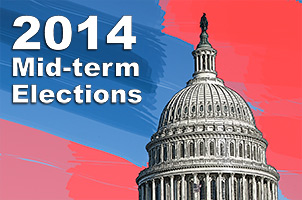 |
A
Referendum on Obama The "six-year itch," wherein a president's party typically loses congressional seats during his sixth year in office, posed a huge challenge for Democrats in 2014. In race after race Republicans sought to tie the Democratic candidate to President Obama. Democrats in turn sought to paint their Republican opponents as extremists, waging a war on women, against increases in the minimum wage, and generally obstructing progress on all fronts. The elections, which broke records for mid-term spending, occurred in an atmosphere of strong dissatisfaction with the gridlock in Washington, DC. Turnout was the lowest in 72 years. |
|
The 2014 midterms resulted in
setbacks for Democrats at all levels, setting the stage for the 2016
presidential campaign and potentially hurting the party in subsequent
cycles. Most
closely
watched
in 2014 was
the battle for control of the U.S. Senate, where 36 seats were up and
Republicans needed a net gain of six seats.
Conventional wisdom was that the U.S. House, where Democrats needed to
pick up 17
seats, was certain to
remain under Republican control. In addition to House and Senate
contests, 36 gubernatorial
races,
other statewide races, myriad state legislative races, and a range of
ballot measures made for a busy election season.
Challenges for Both Parties Both parties faced challenges in 2014, but the climate for Democrats was particularly daunting due to the six-year itch and the unpopularity of President Obama. Republicans sought to make the campaign a referendum on President Obama, effectively a national campaign, although the effectiveness of that approach varied from race to race. President Obama was scarce on the campaign trail, but his fundraising ability did help to boost the coffers of the Democratic party committees. Where Democrats fell short was in the absence of a compelling message. Overseeing the White House's strategy was David Simas, director of the Office of Political Strategy and Outreach. A question for Republicans was "would they get their act together?" In 2010 and 2012 Republicans fell short in their efforts to retake the Senate as several of their candidates imploded; analyst Charlie Cook likes to refer to Republican problems with "exotic candidates." In 2012 Mitt Romney felt sure he would win only to come up short. Following Romney's defeat, the RNC undertook a major effort to remake the party through its Growth and Opportunity Project (+), and the outcome of the mid-terms shows a measure of the success of those efforts. A major story line at the beginning of the 2014 cycle was whether friction between Tea Party and establishment elements would lead to messy and damaging primaries. Generally in the 2014 cycle the Republican party committees worked well together, electing favored candidates in their primaries, training them to avoid pitfalls and projecting optimism (+). Issues In any campaign, particularly in the current highly politicized environment, serious discussion of problems and challenges facing America inevitably seems to give way to charges and counter-charges, charged rhetoric, and attention to wedge or hot button issues. Attack ads from outside groups further fuel these flames. The American economy had improved steadily but slowly since the great recession. The unemployment rate for Oct. 2014 stood at 5.8% (>), real GDP increased by 5.0 percent in the third quarter of 2014 (3.5 percent in the original estimate) (>), and by late October gas prices in many states were below $3 per gallon. Yet there remained a sense of unease. Millions had left the workforce and wages had stagnated. The national debt in October 2014 stood at $17.9 trillion. Issue number one for most candidates out on the trail was jobs. Illegal immigration was a hot button issue. Activists pushed for a stop to deportations and bold action from President Obama. A new wrinkle was added in mid-2014 as thousands of unaccompanied children from Central America made dangerous trips to the U.S. border, creating a crisis atmosphere. In June 30 remarks in the Rose Garden, Obama spoke of executive action before the end of summer (+), but with Republicans on the alert and some Democrats concerned about the effects of such a move as well, the president said in early September that he would delay action until after the midterms (+). The realm of foreign affairs seemed fraught with trouble spots. In a July 13 interview on CNN, Sen. John McCain (R-AZ) stated, "I do believe that the things we’re seeing in the world today, in greater turmoil than at any time in my lifetime, is a direct result of an absence of American leadership." Rising to the top were Ebola, the threat posed by ISIL (+), and, earlier in the year, Russian intervention in Ukraine. |
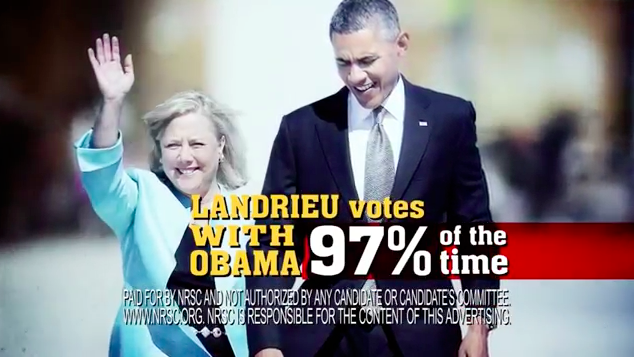 |
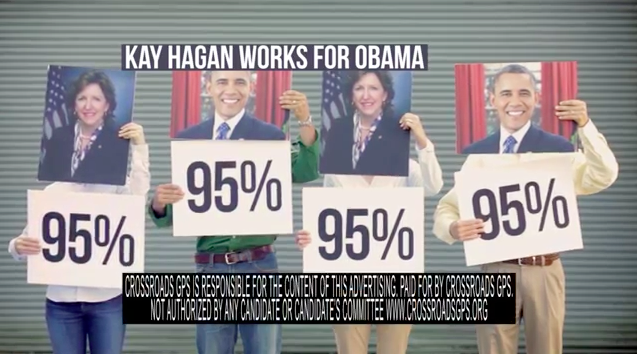 |
|
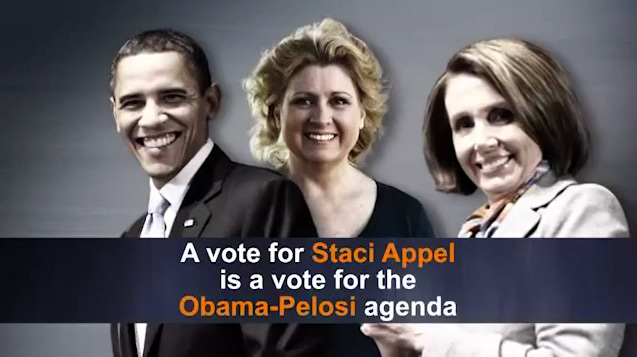 |
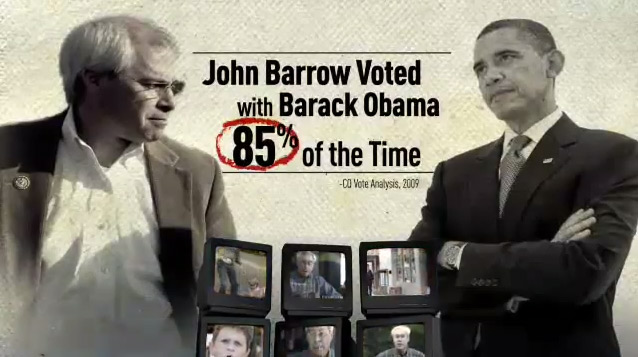 |
|
President
Obama
starred
in many ads including these from NRSC,
Crossroads GPS and NRCC.
|
|
President Obama was
target number
one for Republicans. In race after race Republican challengers
repeated over and over, time and again, repeatedly, incessantly and
multiple times that the
Democratic incumbent voted
with Obama x-percent of the time ("x" generally being a number over
90). At the top of the list of complaints about Obama for many
Republicans was Obamacare/the
Affordable
Care Act, but there were a whole constellation of other issues as
well. GOP candidates espoused a general message against
Washington, big government, spending and taxes. They pushed back
against executive overreach by Obama; in June, for example,
Speaker
Boehner announced that he would initiate a lawsuit against the
president (a, b).
(Some
grassroots conservatives even called for impeachment, although
elected officials and party leaders eschewed such talk (+)). IRS targeting of
conservative
groups prompted outrage and continuing investigations. Benghazi
continued to be a concern for some of the base, and House
Republicans formed a select committee to look into the matter again (+).
Obama's deferral of a decision on the Keystone XL pipeline also
drew considerable criticism. The Democratic congressional leaders
were also targets. Republicans sought to "Fire Reid" arguing that,
"Under
the control of Harry Reid, the U.S. Senate has failed to listen to the
American people and do what’s in their best interest (+)." Likewise, Republicans
sought to send
House
Democratic Leader Nancy Pelosi back to San Francisco.
Democrats meanwhile sought to portray Republican candidates as extremists. Early on, Democrats found a target in the Ryan budget, passed by the House on April 10, charging that Republicans would make draconian cuts to essential programs. The "war on women" emerged as a frequent theme. Democrats sought to make raising the minimum wage an issue. On July 16, House Democrats presented "Middle Class Jumpstart: 100-Day Action Plan to Put the Middle Class First (+)." Democrats and their allies also tried to make an issue of spending by the billionaire Koch brothers (a, b, c). All in all it added up to a less than compelling message. On Oct. 2, 2014 the two parties' visions were set in contrast as RNC chairman Reince Priebus and President Obama separately delivered speeches which set out their contrasting views (a, b). Obama declared that "progress has been hard, but it has been steady and it has been real," and he outlined "what we’ve...been doing structurally to make sure that we have a strong foundation for growth going forward." Priebus presented GOP "Principles for American Renewal," describing "bottom-up solutions founded in the free market, compassion, responsibility, and the idea that America is headed for better days." Money (1) All told, the Center for Responsive Politics estimated that $3.67 billion was spent on federal campaigns in the 2014 midterm election by candidates (43%), parties (30%), outside groups (14%) and others (13%). Donors on the left and on the right spread their largesse among a whole constellation of campaigns, party committees, partisan groups and social welfare organizations (+). The U.S. Supreme Court's April 2, 2014 ruling in McCutcheon vs. FEC, striking down aggregrate contribution limits to federal candidates and committees, accentuated the role of big money in campaigns. Much of the money went to buy TV advertising. The Wesleyan Media Project reported that an estimated $1.19 billion was spent on 2.2 million ad airings in federal and gubernatorial campaigns from Jan. 1, 2013 to Oct. 23, 2014, and when other races (statewide, state legislative, ballot measures and local offices) are added the total rises to 2.96 million ad airings at an estimated cost of $1.67 billion. The data show increasing numbers of ads by dark money groups that are not required to disclose donors. In tightly contested races, outside spending can significantly exceed spending by the campaigns themselves. For example, the most expensive Senate race occurred in North Carolina, where the Hagan and Tillis campaigns spent $34.7 million and outside groups spent $80.5 million, for a total of $115.2 million. The most expensive House race, in CA-7 between Rep. Ami Bera (D) and Doug Ose (R), tallied $22.8 million, $13.5 million by outside groups and $9.3 million by the campaigns. The most expensive gubernatorial campaign occurred in Florida, where, according to data from Kantar Media/CMAG analyzed by the Wesleyan Media Project an estimated $77 million was spent just on the ad war. Voting Wars Unbelievably, with just one month to go until Election Day, wrangling over voter identification laws (2) and other restrictions on voting continued (+). Over a period of about three weeks, the U.S. Supreme Court weighed in on challenges to restrictive voting laws in four states; in each case the Court blocked lower court decisions to avoid potential disruption to voting. On Sept. 29, 2014 the Court issued an order in Husted v. NAACP, effectively eliminating a week of early voting in Ohio. In an October 8 opinion in North Carolina v. League of Women Voters of North Carolina the Court effectively kept in place restrictions on same-day registration and voting in the wrong precinct brought about by the wide-ranging House Bill 589. On October 9, in Frank v. Walker, the Court effectively blocked Wisconsin from implementing its voter ID law. On October 18 in Veasey v. Perry the U.S. Supreme Court effectively allowed Texas' voter ID law to stand. In addition, on October 15 the Arkansas Supreme Court struck down that state's vote ID law. Election officials in these states were kept on their toes. Dissatisfaction A very significant underlying theme in 2014 was a lack of faith in the system. Congressional job approval ratings in the 9 to 15% range (3, 4) should raise concerns about the functioning of the world's greatest democracy, as should low, in many cases abysmally low turnout. It is true that both parties and many groups worked to register new voters and expand the electorate (D, R), but the net effect fell short. For the primaries, a report by the Center for the Study of the American Electorate found that in the first 25 primaries of 2014 the percentage of eligible citizens who voted was 14.8-percent, down from 18.3-percent in 2010, and that turnout in 15 states reached record lows (5 [PDF], +). The United States Elections Project estimates (as of 12/16/14) that 35.9-percent of the voting-eligible population (33.2-percent of the voting-age population) or 81.7 million people voted in the midterms (6, +). Republican Wave The midterms produced a Republican wave—eleven new governors (7 Republican), 12 new U.S. Senators (all Republican) and 61 new U.S. House members (44 Republicans) were elected, not to mention many new Republican state legislators—and this will have important implications for 2016. Debate in the U.S. Senate under Majority Leader Mitch McConnell will be much different than if Harry Reid had retained his position. Republican control of governorships in so many states, including such swing states as Florida, Ohio and Wisconsin, may provide a boost for the Republican presidential nominee. In addition to being a success for Republicans, the midterms showed that Democrats have considerable work for 2016 (a, b). Notes: 1. On spending see: OpenSecrets.org "2014 Election Overview" and "2014 Outside Spending, by Group" OpenSecrets.org. "Overall Spending Inches Up in 2014: Megadonors Equip Outside Groups to Capture a Bigger Share of the Pie." Oct. 29, 2014. Wesleyan Media Project. "Interest Group Advertising Pours Into Senate Races." April 29, 2014. "Heated Battle for U.S. Senate Draws Deluge of Outside Ads, Most Are Dark Money." Sept. 4, 2014. "2014 General Election Advertising Opens Even More Negative than 2010 or 2012," Sept. 16, 2014. "GOP Groups Keeping Senate Contests Close." Sept. 30, 2014. "Ad spending in 2014 elections poised to break $1 billion." Oct. 20, 2014. "Ad Spending Tops $1 Billion, Yet Ad Volume is Down From Last Midterm Election." Oct. 29, 2014. also: Ian Vandewalker. "Analysis: Outside Spending and Dark Money in Toss-Up Senate Races." Brennan Center for Justice, Oct. 9, 2014. 2. U.S. Government Accountablity Office. "Issues Related to State Voter Identification Laws." [GAO-14-634] Published Sept. 19, 2014; publicly released Oct. 8, 2014. 3. Gallup. "Congressional Job Approval Ratings Trend (1974-Present). 4. Gallup. "In U.S., 65% Dissatisfied With How Gov't System Works." Jan. 22, 2014. 5. Center for the Study of the American Electorate. "National Turnout Trending Toward Record Low." July 21, 2014. 6. United States Elections Project. "2014 November General Election Turnout Rates." Updated Dec. 16, 2014. MEMO CORNER: RNC [10/20/14] | DCCC [07/15/14] | NRCC [05/09/14] | RNC [04/14/14] | DSCC [03/24/14] | DCCC [02/26/14] | RSLC [02/04/14] | EMILY's List [11/12/13] | NRCC [11/04/13]. Submit a memo: action08 at gmail dot com |
| Mobilizing
the
Base |
||
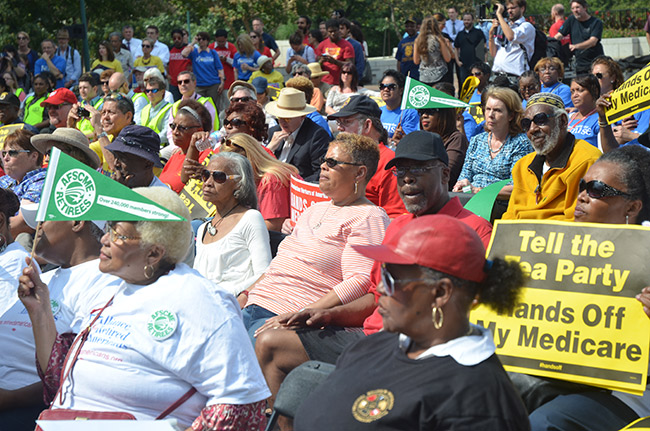 |
 |
|
| Sept. 18, 2014 -
Americans United for Change "Hands Off Social Security and Medicare -
We Earned It!" rally. |
Sept. 25-27, 2014 -
Values Voter Summit. |
Congressional Primary Dates (source FEC [PDF]...does not include runoff dates...links to SOS/election offices added)
For New York June 24 is the federal primary date and Sept. 9 is the state office primary date.
and see also: Roll Call's Casualty List
ADVERTISEMENT
